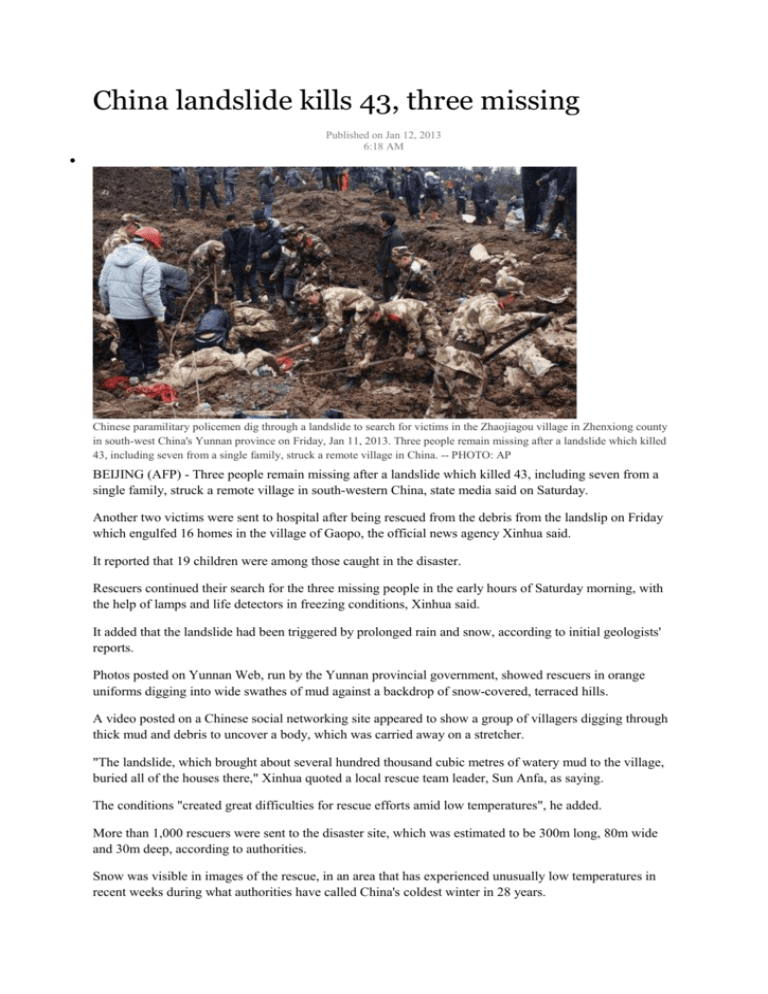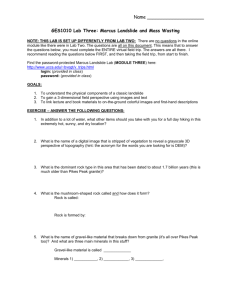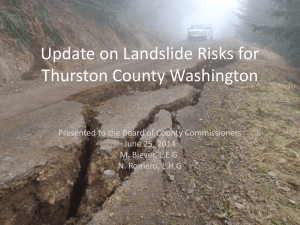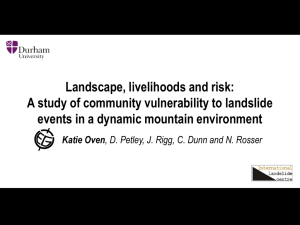Hazards and Management
advertisement

China landslide kills 43, three missing Published on Jan 12, 2013 6:18 AM Chinese paramilitary policemen dig through a landslide to search for victims in the Zhaojiagou village in Zhenxiong county in south-west China's Yunnan province on Friday, Jan 11, 2013. Three people remain missing after a landslide which killed 43, including seven from a single family, struck a remote village in China. -- PHOTO: AP BEIJING (AFP) - Three people remain missing after a landslide which killed 43, including seven from a single family, struck a remote village in south-western China, state media said on Saturday. Another two victims were sent to hospital after being rescued from the debris from the landslip on Friday which engulfed 16 homes in the village of Gaopo, the official news agency Xinhua said. It reported that 19 children were among those caught in the disaster. Rescuers continued their search for the three missing people in the early hours of Saturday morning, with the help of lamps and life detectors in freezing conditions, Xinhua said. It added that the landslide had been triggered by prolonged rain and snow, according to initial geologists' reports. Photos posted on Yunnan Web, run by the Yunnan provincial government, showed rescuers in orange uniforms digging into wide swathes of mud against a backdrop of snow-covered, terraced hills. A video posted on a Chinese social networking site appeared to show a group of villagers digging through thick mud and debris to uncover a body, which was carried away on a stretcher. "The landslide, which brought about several hundred thousand cubic metres of watery mud to the village, buried all of the houses there," Xinhua quoted a local rescue team leader, Sun Anfa, as saying. The conditions "created great difficulties for rescue efforts amid low temperatures", he added. More than 1,000 rescuers were sent to the disaster site, which was estimated to be 300m long, 80m wide and 30m deep, according to authorities. Snow was visible in images of the rescue, in an area that has experienced unusually low temperatures in recent weeks during what authorities have called China's coldest winter in 28 years. The Communist Party's top leaders Xi Jinping and Li Keqiang, along with Premier Wen Jiabao, ordered "all-out efforts to rescue victims", Xinhua said It reported that villagers had rushed to the scene with shovels and hoes to dig through the mud. "We pulled out several people, one of whom was breathing weakly, but after a while he died," resident Li Yongju told Xinhua. Another resident, Zhou Benju, said she had lost several relatives in the disaster, according to the agency. "Several relatives of my parents, my grandma, brother, uncle and my aunt's family members died," she said. Yunnan province, which borders Myanmar, Thailand, Laos and Vietnam, is a relatively poor part of China where rural houses are often cheaply constructed. Gaopo is in Zhenxiong county, in the northeast of Yunnan, a temperate province known for its tobacco industry and for being the home of Pu'er tea. But its mountainous areas are prone to landslides and earthquakes. Two in September - one of magnitude 5.7 - left 81 people dead and hundreds injured. Mr Wen made an overnight trip to the quake zone at the time to comfort survivors, many of whom had taken refuge in tents erected on a public square. A county neighbouring Zhenxiong was hit by a landslide in October that killed 18 children, after one which killed 216 people in 1991, according to the United States Geological Survey. An earthquake in neighbouring Sichuan province in 2008 claimed around 70,000 lives - the worst natural disaster to hit China in three decades, with shoddy buildings blamed for the high toll. Nineteen children among 46 dead in China landslide Published on Jan 12, 2013 2:22 PM Chinese paramilitary policemen dig through a landslide to search for victims in the Zhaojiagou village in Zhenxiong county in south-west China's Yunnan province on Friday, Jan 11, 2013. Three people remain missing after a landslide which killed 43, including seven from a single family, struck a remote village in China. -- PHOTO: AP BEIJING (AFP) - A desperate search for three people missing in a landslide in south-western China ended on Saturday when their bodies were pulled from the mud, taking the final death toll to 46 - many of them children. Authorities in Yunnan province said that the last three bodies were recovered on Saturday morning after a night of frantic efforts by more than 1,000 rescue workers to locate the final missing residents of the remote village of Gaopo. The official Xinhua news agency said those buried included 27 adults and 19 children. Two other people were hospitalised after the landslide struck on Friday morning, engulfing 16 homes, bringing a thunderous crash and throwing up thick clouds of dust, Xinhua said. Rescuers toiled into the night, braving bitter wind and freezing temperatures, using lamps and specialised detection devices in the hope of locating the missing, the agency added. Soldiers, police, firefighters and mine rescue workers joined the search operation, using 20 excavators and trucks, it added. Madam Li Yongju, 50, said she heard the crash of the landslide while cleaning her yard and rushed with other villagers to the disaster site with shovels and hoes. "We pulled out several people, one of whom was breathing weakly. But after a while, he died," Xinhua quoted her as saying. Madam Zhou Benju wept as she recounted hearing the rumble of the landslide. "Several relatives of my parents - my grandma, brother, uncle and my aunt's family members, died," she told the agency. Hundreds of thousands of messages of support had been posted on microblogging site Sina Weibo. "Pray for those who remain missing in the debris. Life is too fragile. We only wish miracles can happen!" read one post. "It is a tragedy, a real tragedy!" wrote another on Sohu.com. Photos on Yunnan Web, run by the Yunnan provincial government, showed rescuers in orange uniforms digging into wide swathes of mud against a backdrop of snow-covered, terraced hills. A video posted on a Chinese social networking site appeared to show a group of villagers digging through thick mud and debris to uncover a body. Xinhua said that the landslide had been triggered by 10 days of non-stop rain and snow, according to initial geologists' reports. The area has experienced unusually low temperatures in recent weeks during what authorities have called China's coldest winter in 28 years. The landslide spread over an area 120 metres long, 110 metres wide and 16 metres deep, according to authorities. The Communist Party's top leaders Xi Jinping and Li Keqiang, along with Premier Wen Jiabao, ordered "all-out efforts to rescue victims", Xinhua said. Yunnan province, which borders Myanmar, Thailand, Laos and Vietnam, is a relatively poor part of China where rural houses are often cheaply constructed. Gaopo is in Zhenxiong county in the north-east of Yunnan, a temperate province known for its tobacco industry and for being the home of Pu'er tea. But its mountainous areas are prone to landslides and earthquakes. Two quakes in September - one of magnitude 5.7 - left 81 dead and hundreds injured. A neighbouring county was hit by a landslide in October that killed 18 children, after one that killed 216 people in 1991, according to the United States Geological Survey. An earthquake in neighbouring Sichuan province in 2008 claimed around 70,000 lives - the worst natural disaster to hit China in three decades -with shoddy buildings blamed for the high toll. As Australia bushfires rage, govt report warns of more heatwaves Published on Jan 12, 2013 10:31 AM A bushfire burns out of control in the Kiewa Valley towards the town of Dederang in the Victoria Alps on February 10, 2009. Firefighters were battling scores of wildfires raging in Australia on Saturday, as a government commission warned that climate change had raised the risk of scorching heatwaves becoming more frequent. -- PHOTO: AFP SYDNEY (AFP) - Firefighters were battling scores of wildfires raging in Australia on Saturday, as a government commission warned that climate change had raised the risk of scorching heatwaves becoming more frequent. In the eastern state of New South Wales, some 1,000 firefighters were attempting to douse 95 wildfires, 12 of them burning uncontained, while fires were also burning in neighbouring Victoria and Queensland states. And in the southern island state of Tasmania, known for its cooler temperatures, residents were returning to the burnt-out homes they fled a week ago when flames raced through villages on the Tasman peninsula. No deaths have been reported from the bushfires, which have flared during extreme summer temperatures, but the unprecedented heatwave has prompted the government's Climate Commission to issue a new report on the weather event. It says that climate change has contributed to making the extreme heat conditions - in which recordbreaking temperatures in parts of the country have topped 45 deg Cel - and bushfires worse. "The length, extent and severity of the current heatwave are unprecedented in the measurement record," says the report titled "Off the Charts: Extreme Australian summer heat". "Although Australia has always had heatwaves, hot days and bushfires, climate change is increasing the risk of more frequent and longer heatwaves and more extreme hot days, as well as exacerbating bushfire conditions." It says while many factors influence the potential for bushfires, so called "fire weather" is highly sensitive to changes in climatic conditions. And hotter temperatures, longer heatwaves, high winds and drier soil and grass can all dramatically exacerbate fire conditions. "Thus when fire occurs in more extreme weather conditions, there is the potential for the fire to be far more intense and difficult to control," the report says. One of the report's authors, Mr David Karoly, said there was clear evidence of an increasing trend in hot extremes in Australia, where the current heatwave has affected more than 70 per cent of the vast continent nation. "What it means for the Australian summer is an increased frequency of hot extremes, more hot days, more heat waves and more extreme bush fire days and that's exactly what we've been seeing typically over the last decade and we will see even more frequently in the future," he told the ABC. Wildfires are a fact of life in arid Australia, where 173 people died in the 2009 Black Saturday firestorm, the nation's worst natural disaster of modern times. As owners returned to their gutted homes this week in the small communities of Dunalley and Murdunna in Tasmania, they were aware things could have been worse. "Never mind these things can be replaced, it's not a problem," one man told the ABC as he surveyed his destroyed holiday home in Murdunna.







